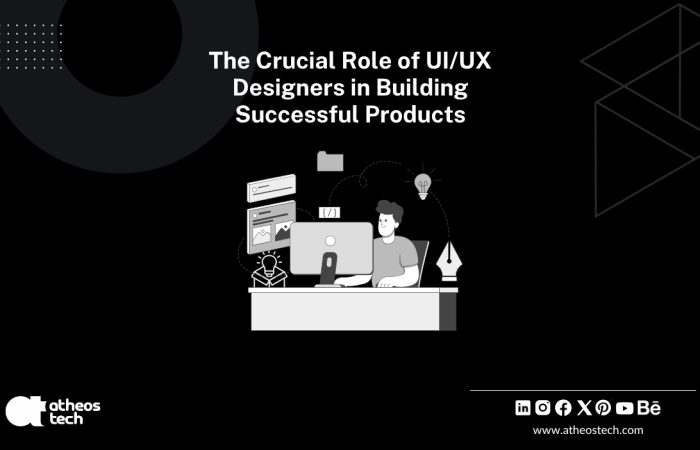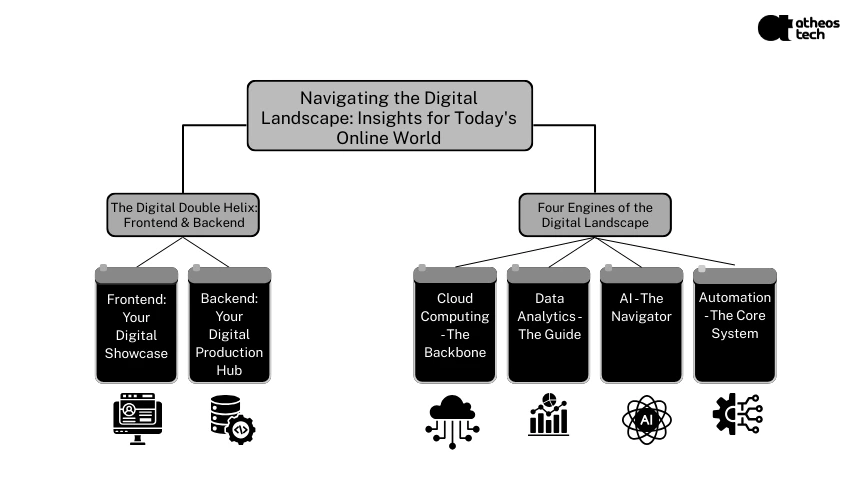
Hire UI UX Designer to Transform Your Brand Across Every Digital Channel

Are you & your business digitally transformed? If not – you’re not the one who hasn’t adapted, but you’re the one – who is left behind.
Digital transformation isn’t coming. It’s here, it’s accelerating, and the winners won’t be the ones with the most tools, they’ll be the ones who understand the terrain.
You’ve heard the fancy things – AI, Cloud, Data, IoT – but what do they actually mean for your business? More importantly, how do you make sense of them all without getting lost in the jargon jungle?
In our previous guides, we gave you the why and the how of transformation:
But now, it’s time to zoom out and take a look at the bigger and practical picture.
Let’s address the bigger question:
“What is the digital landscape we’re even navigating?”

Because here’s the brutal truth – most small and mid-sized business leaders are operating without a map. They’re surrounded by disconnected tech conversations, and promises of small business IT solutions – without a strategy.. The result? Fragmented decisions, siloed implementations, and a strategy that’s reactive at best; chaotic at worst.
Let’s fix that.
Before we dive into tech stacks, platforms, or buzzword bingo, let’s establish a first principle:
Digital transformation doesn’t happen in a vacuum, it happens across two distinct but inseparable arenas.
One faces the world. The other powers the engine room.
And ignoring either one? That’s not just risky – it’s fatal.
The Core Concept:
Frontend is how you make promises.
Backend is how you keep them.
Or to put it differently:
Frontend is your digital storefront; where customer impressions are made, demand is captured, and your brand is lived.
Backend is your digital factory; where operations, processes, and fulfillment happen at scale.
Your website, mobile app, email campaigns, marketing automation, social media, customer portals, chat interfaces, and anything else that speaks to the customer.
It exists:
Core focus:
Frontend tools typically lead in Phase 1 and Phase 2 of transformation. This is where many SMBs start, because it’s visible, flashy, and feels like progress.
But here’s the cat
ERP systems, CRM, inventory management, finance and accounting tools, HR systems, internal communication platforms, and process automation tools.
Your backend – the true engine behind your small business IT solutions ensures you can scale with integrity. Its strategic role is to deliver on the promises made upfront – efficiently, accurately, and at scale.
Core focus:
Backend transformation becomes essential in Phase 2 and is non-negotiable in Phase 3. This is where SMBs either scale or stall.
As a small business consultant, we can tell you: polishing your digital storefront without fixing the backend is a fast track to failure.
Here are some cases why digital transformation never happens for most SMBs:
Now that you’ve seen the map – Frontend & Backend – it’s time to look under the hood.
Because businesses don’t run on magic.
They run on engines. And in today’s digital economy, there are four you simply can’t ignore.
We call them the Big Four. Together, they form the new operating system of business: Scalable, data-driven, intelligent, and automated.
You don’t have to be an engineer to lead a digital company. But you must know what these engines do, and what happens when they’re missing.
These technologies don’t compete. They stack; like layers in your digital infrastructure. One enables the next. Together, they unlock true transformation.
Let’s meet the engines powering your future:
Cloud platforms like AWS, Azure, and Google Cloud are your infrastructure layer. They let you scale on demand, work from anywhere, and stop worrying about server rooms and downtime.
Cloud is the base utility – your electricity and plumbing for the digital age. It powers collaboration, remote work, data storage, and scalability. Modern small business IT solutions rely heavily on cloud platforms to stay agile and scalable.
Where it shows up:
Consultant’s Note:
Cloud isn’t just about tech – it’s about agility. It changes your cost model, your security posture, and your speed to innovate.
Tools like Power BI, Tableau, and Zoho Analytics transform raw data into actionable insight. They help you see patterns, detect trends, and make smarter decisions – faster.
Frontend Applications:
Backend Applications:
Consultant’s Note:
Our consulting services for small businesses often begin here, because too many SMBs collect data but never convert it into clarity.
AI isn’t some sci-fi overlord. It’s your predictive assistant. From chatbots to forecasting tools, AI helps you work smarter, not harder.
Think:
Frontend Applications:
Backend Applications:
Consultant’s Note:
You don’t need to “do AI.” You need to apply AI – strategically. One model can unlock insights that a team of analysts might miss.
This is the connective tissue. Platforms like Zapier, Make, or custom APIs automate repetitive tasks and stitch disconnected tools into one seamless flow.
Automation doesn’t replace people. It frees them.
Frontend Applications:
Backend Applications:
Consultant’s Note:
Your tech should talk to itself before it talks to you. If you’re manually exporting spreadsheets to connect systems – this engine isn’t running.
| Engine | Purpose | Role in Frontend | Role in Backend |
|---|---|---|---|
| Cloud | Infrastructure | Hosting, collaboration | Centralized ops |
| Data | Insight generation | Customer behavior | Operational KPIs |
| AI | Prediction & decisions | Personalization | Forecasting |
| Automation | Efficiency & flow | Workflow triggers | Task elimination |
Ready to align your frontend and backend?
Now that you have the map and understand the engines, how do you decide which road to take first?
The way forward isn’t to buy more tech. It’s to think more strategically. Before you invest in any new digital initiative, you must run your decision through this simple, three-part strategic filter.
Look at your business through the Two Hemispheres model.
Most SMBs don’t have a tech problem. They have a misalignment problem.
They polish the storefront while the warehouse is on fire. Or they build robust backend workflows while ignoring customer-facing chaos.
Start with brutal honesty: Where are the cracks?
That’s where your roadmap begins.
Define the Business Problem – Before Mentioning Tech
Repeat after me:
“We’re not buying a tool. We’re solving a business problem.”
Louder…
Every tool should trace back to a single sentence that defines your objective. For example:
Wrong: We need AI
Right: We want to predict which leads are most likely to convert.
Wrong: Let’s automate onboarding.
Right: We want to reduce new employee onboarding time by 30% without adding HR headcount.
When you anchor the conversation in business outcomes, the right technologies reveal themselves. Otherwise, you’re just collecting logos.
Digital transformation is a journey through complex, high-stakes terrain. The worst move you can make?
Waiting to call for help until things are on fire.
Bring in expertise early – not just a tech vendor, but a strategic guide who can:
You wouldn’t climb Everest with a guy who sells tents.
You’d hire a Sherpa.
The same applies here. Don’t trust a vendor; partner with one of the leading small business consulting firms who has navigated the terrain before.
Map before you move.
Align before you automate.
Think before you integrate.
That’s how transformation becomes sustainable, and scalable.
Ready to grow smarter?
Let AtheosTech guide your digital journey
Let’s cut through the noise:
The greatest threat to SMBs today isn’t missing out on the next big thing.
It’s building on a shaky foundation – a collection of shiny tools duct-taped to a business with no strategic spine.
You don’t need to become a master of every technology to win. You just need to understand how they apply to your business. Stop patching together random small business IT solutions. Start with a system that aligns with your real business objectives.
The real risk in today’s economy isn’t missing out on the next hot technology; it’s building your company’s future on an unstable, unplanned digital foundation. The map we’ve provided in this guide is your tool to stop chasing trends and start aligning your digital investments with real-world results.
The entire landscape can now be seen through a simple but powerful strategic lens:
Frontend vs. Backend defines your Business Structure.
The Four Engines are your Technology Enablers.
When you see this clearly, every future decision becomes easier.
Vendor pitches make more sense. Tool selection becomes strategic.
Investments become compounding, not confusing.
So, what now?
If you’ve been feeling stuck, scattered, or unsure of what to do next, pause the tool hunt.
Step back. Zoom out. Orient before you accelerate.
And when you’re ready to move – move strategically.
As a dedicated small business consulting company, we don’t throw tools at problems – we diagnose, design, and deliver transformation that makes sense.
Book a complimentary Digital Systems Discovery Call – 30 minutes.
Adding {{itemName}} to cart
Added {{itemName}} to cart